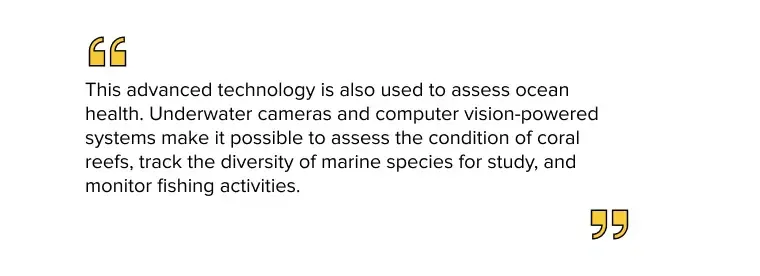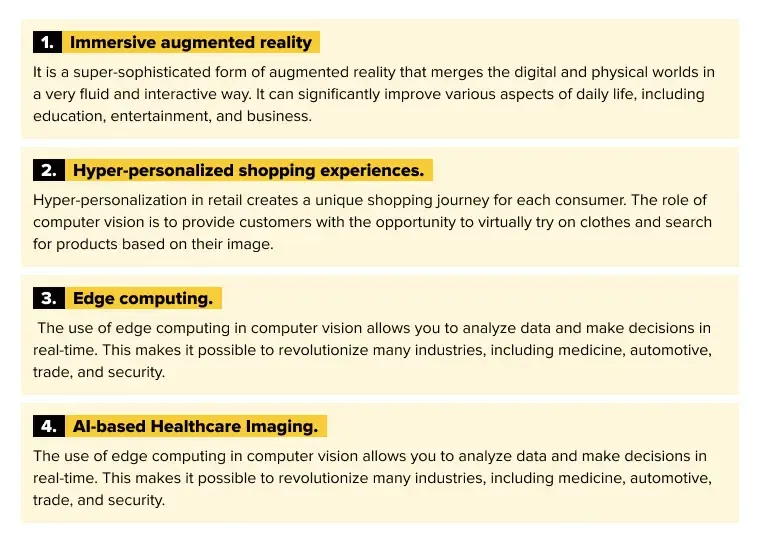It is difficult to imagine the digitized future of modern society without computer vision and artificial intelligence (AI), technologies that are already in use and continue to develop at a rapid pace. According to Precedence Research, the size of the AI market in Computer Vision (CV) in 2023 was $17.4 billion, and it will reach a record $274.8 billion by 2033.
In this material, Lampa.dev experts will help you understand the features of this technology and tell you about computer vision use cases in various areas of everyday life and business.
What is Computer Vision?
Computer Vision is a field of artificial intelligence that gives computers the ability to recognize different types of visual information from the real world.

The operating principle of computer vision is constant learning, as a result of which the computer can recognize visual objects. The algorythm processes huge amounts of data, analyzes, compares, looks for differences, until, in the end, learns to recognize the required object.
Core Technologies Behind Computer Vision
Computer vision is based on many modern technologies. They include hardware technologies – sensors and cameras to detect visual objects, data that can be used for training artificial intelligence models, cloud technologies for their deployment, and many others.
However, today we want to focus on the main software technologies that enable computer vision: neural networks, machine learning, and image recognition. They are fundamental components of CV that enable systems to effectively recognize and interpret visual information.
Neural Networks
It is an artificial intelligence method that teaches a computer to process information according to the principle of operation of biological neural networks, i.e., the human brain.
In computer vision applications, the following types of neural networks are used:
ultra-precise neural networks (CNN), created specifically for automatic learning of spatial hierarchies of objects in input images;
recurrent neural networks (RNN), used to analyze sequences of images, for example, videos;
Generative Adversarial Networks (GANs), used to generate realistic images and increase their resolution.
Machine Learning
It is a subsection of artificial intelligence that involves teaching artificial intelligence models using data arrays. In other words, computers can perform tasks without explicit instructions by relying on patterns. In computer vision, machine learning allows numerous applications to learn from visual data and improve over time.
Computer vision may use the following machine learning methods:
Supervised Learning: models are trained on datasets where each image has its own label. Used to classify visual objects.
Unsupervised Learning: artificial intelligence models train on unlabeled data, independently identifying patterns. This method is useful for clustering similar images and detection of defects.
Semi-Supervised Learning: combines a small amount of labeled data and a large amount of unlabeled data. Necessary to improve model performance.
Reinforcement Learning: models are trained during interaction with the environment and based on receiving feedback (rewards or punishments). Widely used in such complex exciting applications like robotic navigators.
Image Recognition
Image recognition plays a key role in computer vision technology as it involves identifying and detecting objects. There are several ways to use image recognition in CV:
Object Detection: a method used not only to identify objects but to determine their location.
Facial Recognition: technology that allows the analysis of facial features to confirm a person's identity.
Image Classification: assigns an object to one of the predefined classes.
Semantic Segmentation: an algorithm that assigns labels to each pixel in an image so the system can be used to recognize various objects.
Instance Segmentation: a CV task that allows you to identify and separate objects within a single image.
Optical Character Recognition (OCR): converting scanned documents – such as PDF files – into documents in editable formats.
Image Captioning: a CV task used to create a text description of an image.
The broad capabilities of all the technologies listed above encourage developers and business owners to rely on use of computer vision in their digital solutions.
Let's look at the main examples of computer vision apps used in various areas of modern life.
Key Applications of Computer Vision
Computer vision-enabled applications can perform many processes in various areas of daily life faster and more accurately. Below, you will find a list of industries in which CV is used most often and effectively.
Everyday Consumer Applications
All smartphone owners use computer vision on their devices every day. For example, this technology is used to improve the cameras of modern gadgets for autofocus, image stabilization, or creating a portrait photo.
Computer vision is also used on social networks. For entertainment purposes, this technology is used to create AR filters that are superimposed on users' faces in real time. Another purpose of using CV, this time more practical, is to recognize and filter unwanted content.
Besides, computer vision enhances functionality of voice assistants – for example, Google Assistant and Amazon Alexa. It is possible thanks to the identification of visual objects.
Industrial and Manufacturing Applications
CV can increase the efficiency and accuracy of production processes. Technology makes it possible to improve product quality – computer vision-powered apps can detect defects in products and check whether their sizes meet the required parameters.
Also, computer vision is being used to improve industrial robots. Thanks to this technology, they can accurately identify the desired objects, manipulate them, and navigate safely in any environment.
Another task that computer vision applications solve very well is inventory management. Such software products completely automate this process. They independently count the number of units of products in the warehouse and monitor the movement of goods.
Retail and Business Applications
Computer vision is a key technology that enables retail businesses to remain competitive. Customized systems help improve customer satisfaction. Virtual try-ons, visual search, and personalized recommendations based on preference analysis all improve the customer experience.
Another area of application of CV in retail is optimization of store operations. Computer vision-powered systems are used to monitor inventory, track visitor movements, and organize merchandise in an orderly manner.
Computer vision applications show good results in preventing shoplifting. Such digital solutions can recognize suspicious behavior and reduce losses.
CV is used for retail and marketing purposes. Computer vision systems are trusted to conduct demographic analysis, evaluate advertising effectiveness based on engagement, and personalize content, taking into account all the information received.
Healthcare Applications
Diagnostics is an area of medicine in which computer vision has made a real breakthrough. The systems analyze X-rays and other examination results and can significantly increase the accuracy and speed of diagnosis. As an example, we can mention a digital solution InnerEye from Microsoft. It helps physicians identify radiotherapy target areas 13 times faster and demonstrates highly accurate results.
Furthermore, CV is used in medicine to identify abnormal cells, which helps in diagnosing cancer. This technology also plays an important role in surgery. With its help, you can improve the accuracy of surgical robotic systems, the efficiency of planning and performing operations. For example, thanks to the combination of computer vision and augmented reality, surgeons during an operation gain access to those organs or vessels that may not be visible without special technologies.
In addition to these core applications, innovative CV-based digital healthcare solutions are being used to care for patients, prevent disease, assist people with disabilities, and improve the operational efficiency of healthcare facilities.
Transportation and Logistics
Computer vision is widely used in a variety of areas of transport and logistics business, from the most general logistic applications, such as inventory management, to specific ones, such as autonomous vehicles.
Speaking about the latter, it is worth mentioning that CV solutions, thanks to optical sensors, can identify visual objects like road users and road signs. This allows self-driving cars to avoid obstacles, stay in the correct lane, and regulate speed.
Fleet management is another important mission of computer vision. Specialized systems determine the condition and optimize the load of vehicles, build an effective route, and track the location of the cargo.
This innovative technology also helps ensure road safety. CV-based applications are trained to recognize defects in the road surface, damage to the integrity of bridges and tunnels, obstacles on railway tracks, etc.
Financial Services Applications
KYC verification and Anti-Money Laundering (AML) are the main tasks for which computer vision is used in financial services apps. KYC processes can be optimized because CV-powered systems automatically extract and verify customer information from documents submitted during the registration process. One way to do this is to compare a photograph of the document with a live or uploaded image of the person.
In terms of anti-money laundering, computer vision's contribution lies in optimizing transaction monitoring through the integration of visual data.
Environmental and Ecological Applications
Computer vision is widely used in ecology to improve the efficiency of environmental protection measures.
One of the areas of CV application is wildlife monitoring and conservation. Good results in species identification are demonstrated by the installation of camera traps. The systems recognize individual animals and make it possible to obtain information about their population without human intervention. To track animals over a large area, aerial photography is used, when drones are equipped with computer vision.
Also, specialized CV-based systems can track the movements of poachers and notify authorities of possible danger.

Other ecology tasks where computer vision is used include monitoring climate change and air quality, monitoring the health of agricultural crops, and much more.
Security and Surveillance
Computer vision may ensure high security in almost every area of modern person’s life. The most common computer vision AI examples include security systems that are used in crowded places like airports or shopping centers. Specialized systems identify suspicious objects, recognize faces and license plates, and detect anomalies in crowd behavior.
Similar systems are also used in private homes to prevent intruders from entering and committing theft.
These are the CV use cases we encounter on a daily basis. However, there are also not so obvious tasks of this technology, which it nevertheless copes with 100%. These include responding to natural disasters and ensuring the safety of renewable energy systems.
In the first case, computer vision is used to detect early signs of an approaching natural disaster and provide timely notification of it. In the second, to detect defects and monitor the performance of solar panels and other devices that generate alternative types of energy.
Emerging Trends in Computer Vision
Due to the enormous capabilities of computer vision, this technology will enter all spheres of human life in the near future. The main trends we will face very soon include:

Conclusion
Computer vision is an innovative technology based on artificial intelligence that can radically change many aspects of everyday life. Nowadays, it is successfully used in medicine, logistics, industry, security, the financial sector, etc.
Do you want to be in trend and beat your competitors with the help of a progressive computer vision application? Contact the experts at Lampa.dev, and we will tell you everything about using this technology in the modern world and create a solution that will change your business.